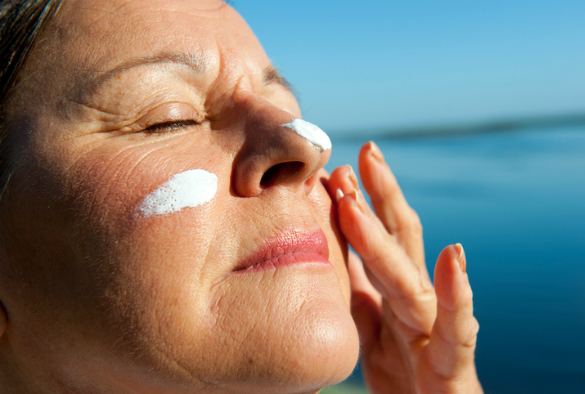When applying sunscreen people miss on average 10 per cent of their face, the most common site for skin cancer, according to University of Liverpool research presented at the British Association of Dermatologists’ Annual Conference in Liverpool this week.
More than 90 per cent of basal cell carcinomas, the most common cancer in the UK, occur on the head or neck, and between five and 10 per cent of all skin cancers occur on the eyelids specifically.
Revealing images
57 participants, male and female, were asked to apply sunscreen to their face with no further information or instructions given by the researchers. Photos were taken of each of the participants with a UV-sensitive camera before and after the application of sunscreen, with areas covered with sunscreen appearing black due to the UV camera. These images were then segmented and analysed by a custom-designed program to judge how successful each person was at covering their whole face.
On average people missed 9.5 per cent of the whole face, with the most commonly missed areas being the eyelids (13.5 per cent) and the area between the inner corner of the eye and the bridge of the nose (77 per cent).
The researchers then asked the participants back to repeat the experiment, this time giving extra information about skin cancers of the eyelid region. Armed with this information there was a slight improvement in the level of sunscreen coverage with 7.7% per cent of the face left unprotected.
As applying sunscreen in these areas is not necessarily practical due to manufacturers’ warnings to keep products out of the eye, it is important to use other forms of protection such as sunglasses.
UV imaging: The photo on the left is before sunscreen application. The photo on the right is after sunscreen application and shows the areas of skins missed around the eyes.
Don’t forget your sunglasses
Dr Kevin Hamill, from the University’s Department of Eye and Vision Science, said: “It’s worrying that people find it so hard to sufficiently apply sunscreen to their face, an area which is particularly at risk of skin cancer due to the amount of sun exposure it receives. Our research shows that simple health messaging can help improve this problem, and we hope that industry groups and public health campaigners can take this on board.”
“Perhaps the most important thing to take away from this research is the importance of sunglasses. Most people consider the point of sunglasses is to protect the eyes, specifically corneas, from UV damage, and to make it easier to see in bright sunlight. However, they do more than that, they protect the highly cancer prone eyelid skin as well.”
Matthew Gass of the British Association of Dermatologists said: “As sunscreen is one of the main protections against UV damage and skin cancer it is vital that people understand how to apply it. Skin cancer is the most common type of cancer in the UK, and numbers continue to rise at a worryingly fast rate.
“We still want people to enjoy themselves outdoors, but to go back to the basics of sun protection, especially those with fair skin that burns easily, and during periods of strong sunshine either in the UK or abroad. These are to thoroughly apply and reapply sunscreen with a minimum of factor 30 and good UVA protection, to wear protective clothing such as a t-shirt or a hat, to wear sunglasses that show the CE mark and British Standard (BSEN1836), and to spend time in the shade when the sun is at its hottest between 11am and 3pm.”
Meet the Scientists
Join Dr Hamill and colleagues at Liverpool World Museum this weekend to find out how effective your sun tan lotion application skills are. Using a UV sensitive camera, the team is offering visitors the chance to have photographs taken before and after sun cream application, to highlight any areas that have been missed. Visitors can also get a print out of the photo to take home.
‘Meet the Scientists’ takes place 10am-4pm on Saturday, 8 July at World Museum, William Brown Street, Liverpool, L3 8EN. For more information please visit: https://www.liverpool.ac.uk/health-and-life-sciences/public-engagement/events/meet-the-scientists/
Save
